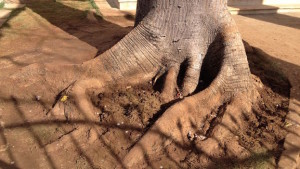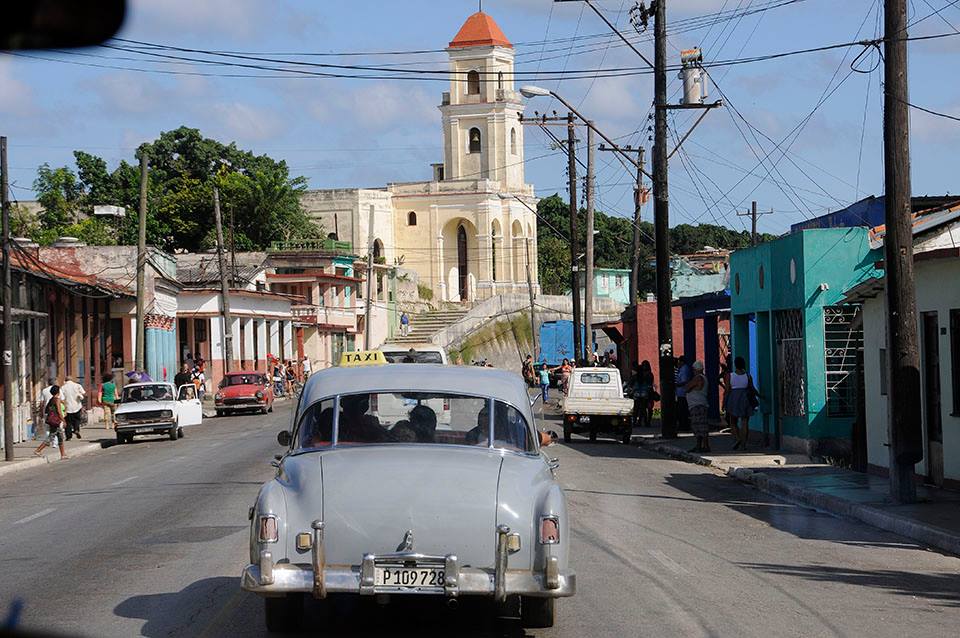CUBA AND A CEIBA TREE THAT ARE DYING.
Babalawos and gentlemen of the government have to be worried about different reasons but with equal intensity. La Ceiba of the Monument of El Templete dies without remedy on them.
The ceiba was already considered sacred among the Maya and Nahuatl people, but the connotation to syncretic cults of African origin this majestic tree native to Central America is enormous. In the Rule of Osha, ceiba is the seat Iroko Iroko or same as the ceiba is enshrined. The abakuás not start their liturgies without pay tribute. Many rituals are developed under its foliage and at the founding of a new power plant a ceiba and make offerings as it says: “If successful, our nation prospers, if dry, our nation will be destroyed.”
The history of ceiba from El Templete is unclear. The Spaniards, surely found in founding the third time the city, and there are those who, against all the popular tradition, considered the tree symbol of derision were subjected to colonial rule breakers and slaves, victims whip, tied the formidable trunk.
The council decided to cut the ceiba on the eve of the construction of El Templete in 1827, arguing for the damages that would bring the construction of monument and which could then planted another or others which may be convenient on the spot. Finally, the City Council saw no need to make up the ceiba, because it decided that the monument to the memory of the first mass and the first town council was perpetuated.
A Cuban unbelievers, in the absence of information they do give interpretations and to establish the relationship between the death of the revered tree and others, whether natural or systemic.
In the case of the ceiba most visited Havana -the current, the people around three times and make a wish while touching a ceremony with the resonance of the legends of Iroko and Aggayú-, when he began to lose foliage, is he sent for specialists wildlife and the Botanical Garden, who searched it and found the cause. Would have taken a geriatrician forest despite the ceiba is a tree that lives long years. However, they have treated with care and, although it is free of pests and approach the public, at present its dead branches and gray trunk that is advertised in the past was limited.
Either by superstition, by targeting higher levels or both, the life of the ceiba of the PA should be extended. Besides Babalawos who seek answers in Ifa, the disbelievers Cubans lip, a lack of information-and not on the health of the precisely-ceiba given by making interpretations and establish the relationship between tree death revered and other deaths, whether natural or systemic.
I dare say that very few of those silent fervor surrounding three times the sacred tree known this little known phrase of Fernando Ortiz: “At that ceiba should attend our habanero people on pilgrimage, whenever you feel depleted their freedoms.” Who would dare today to doubt that many of the devotees of the old tree the spirit of Don Fernando phrase is not present?
14YMedio, La Habana/ Regina Coyula/InternetPhotos/Excerpts.
The Cuban History, Holywood.
Arnoldo Varona, Editor.
CUBA Y UNA CEIBA QUE SE NOS MUEREN.
Los babalawos y los señores del Gobierno han de estar preocupados por razones diferentes pero con igual intensidad. La ceiba de El Templete se les muere sin remedio.
La ceiba ya era considerada sagrada entre los mayas y el pueblo náhuatl, pero la connotación que tiene para los cultos sincréticos de origen africano este majestuoso árbol oriundo de Centroamérica es enorme. En la Regla de Osha, la ceiba es el asiento de Iroko, o es Iroko mismo cuando la ceiba está consagrada. Los abakuás no inician sus liturgias sin antes rendirle tributo. Muchos de sus rituales se desenvuelven bajo su fronda y, al fundarse una nueva potencia, plantan una ceiba y le hacen ofrendas mientras se expresa: “Si prospera, prospera nuestra nación, si se seca, nuestra nación será destruida”.
La historia de la ceiba de El Templete es confusa. Los españoles, con toda seguridad, la encontraron al fundar por tercera vez la ciudad, y hay quien, en contra de toda la tradición popular, considera ese árbol símbolo del escarnio a que eran sometidos los transgresores de la ley colonial y los esclavos, víctimas de latigazos, atados al formidable tronco.
El Cabildo decidió cortar la ceiba en vísperas de la construcción de El Templete, en 1827, con el argumento de los perjuicios que traería a la construcción de monumento y que luego podría sembrarse otra u otras donde fuere conveniente en el propio lugar. Finalmente, el Ayuntamiento no vio la necesidad de reponer esa ceiba, pues decidió que con el monumento se perpetuaba la memoria de la primera misa y el primer cabildo.
A los cubanos descreídos, a falta de información les dará por hacer interpretaciones y establecer la relación entre la muerte del árbol venerado y otras, ya sean físicas o sistémicas.
En el caso de la ceiba más visitada de La Habana ‒la actual, la que las personas rodean tres veces y tocan mientras piden un deseo, una ceremonia con la resonancia de las leyendas de Iroko y Aggayú‒, cuando comenzó a perder follaje, se mandó buscar a los especialistas de flora y fauna y del Jardín Botánico, quienes la revisaron y no encontraron la causa. Habría hecho falta un geriatra forestal a pesar de que la ceiba es un árbol que vive largos años. No obstante, la han atendido con esmero y, aunque se encuentra libre de plagas y se limitó el acercamiento del público, en la actualidad sus ramas secas y el tronco grisáceo anuncian que está en las últimas.
Ya sea por superstición, por orientación de instancias superiores o por ambas, la vida de la ceiba de El Templete debe alargarse. Además de los babalawos, quienes buscarán sus respuestas en Ifá, a los cubanos descreídos de dientes para afuera, a falta de información ‒y no sobre la salud de la ceiba precisamente‒ les dará por hacer interpretaciones y establecer la relación entre la muerte del árbol venerado y otras muertes, ya sean físicas o sistémicas.
Me atrevo a asegurar que muy pocos de los que en silencioso fervor circundan tres veces el árbol sagrado conocen esta poco divulgada frase de Fernando Ortiz: “A esa ceiba debiera concurrir nuestro pueblo habanero en peregrinación, cada vez que sienta mermadas sus libertades”. ¿Quién se atrevería hoy a dudar que en muchísimos de los devotos del añoso árbol no esté presente el espíritu de la frase de Don Fernando?
14YMedio, La Habana/ Regina Coyula/InternetPhotos/Excerpts.
The Cuban History, Holywood.
Arnoldo Varona, Editor.



 CUBA AND A CEIBA Tree that are Dying. + Cuba y Una Ceiba que se nos Mueren.
CUBA AND A CEIBA Tree that are Dying. + Cuba y Una Ceiba que se nos Mueren.

